
Rats and Mice
Rats, mice, voles and muskrats range in size from the tiny Western harvest mouse to the large common muskrat.

Types of Rats and Mice

The Western red-backed vole is among the smaller of the voles in Oregon. The pelage consists of a vaguely demarked reddish-brown or chestnut-brown stripe on the dorsum grading to buffy gray to dark gray on the sides and venter; the tail is indistinctly bi-colored, light grayish-brown above and whitish below.
This vole occurs from the Columbia River south through the Coast Range. It does not occur in the Willamette Valley or other interior valleys west of the Cascade Mountains. It is a denizen of forest habitats, but tends to be most abundant in closed canopy old-growth forests containing an abundance of fallen logs.
It is active throughout the day but most activity occurs below the ground.
Photo by Kathy Munsel, ODFW

The Southern red-backed vole is among the smaller voles in Oregon. The pelage is silvery on the venter and grayish with ocherous on the sides, and with a rusty or reddish stripe on the dorsum; the tail is dark brown or black above and whitish or grayish below.
In Oregon it occurs in the Ochoco, Blue, and Wallowa Mountains southwestward to central Crook County and northern Harney County.
Photo by D. Gordon Robertson, Wikipedia
The white-footed vole is among the smaller voles. The pelage consists of dark bluish-gray hairs tipped with a rich brown or black on the dorsum grading lighter on the sides, thence to light gray to pinkish buff on the venter. The tail is distinctly bi-colored: white or buff on the vental surface, brownish black on the dorsal surface. The dark dorsal stripe is much wider than the lighter ventral stripe. The feet are light grayish.
This vole occurs from Old Fort Clatsop, Clatsop county, and near Rainier, Columbia County, south through the coast range. Various Oregon specimens have been found among mossy stones along a small stream that flows through a heavy forest of Douglas-fir with an understory of sword fern, moss and a tangle of vine maple in or around a salmonberry thicket.
The heather vole is among the smaller voles in Oregon. In appearance, it strongly resembles the montane vole. It is gray to brownish on the dorsum, whitish to grayish on the venter.
Two of nine nominal subspecies are purported to occur in Oregon: the lighter colored P. I. intermedius in the Blue and Wallowa mountains of northeastern Oregon and the darker P. I. oramontis in the Cascade Range.
Heather voles are rather docile creatures; they usually make little attempt to flee or to defend themselves when captured. It is active during daylight hours more frequently than the Southern red-backed vole, but is less active during the day than at twilight or night.

The Little pocket mouse is one of the smallest rodents in North America and certainly the smallest in Oregon. The dorsal pelage is pinkish buff to ocherous buff with overlying blackish hairs; the venter is buff. The tail is bicolored.
In Oregon, this mouse occurs in Harney and Malheur counties.
They exhibit their greatest activity from spring through autumn and spend a large portion of their lives in burrows below the surface of the ground. In winter, they remain underground continuously, relying on stored seeds for energy. When active on the surface, a large portion of their time is spent searching beneath shrubs for seeds. Items are identified as seeds by touch and placed in their pouches by use of the forefeet.
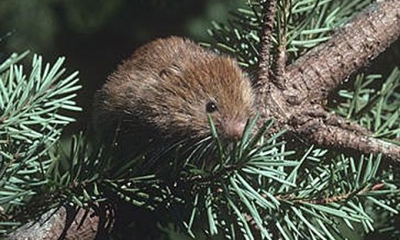
The red tree vole is a medium-sized vole. It is uniquely colored among North American voles: bright orangish-red to cinnamon on the dorsum, silvery gray (often with some light orangish hairs) on the venter, and a tail pale orangish on the venter grading to black on the dorsum.
This vole is endemic to western Oregon. It occurs at moderate elevations on the west slope of the Cascade Range southward as far as the Douglas-Jackson county line and in the Coast Range to the Oregon-California border.
It is largely arboreal and builds nests on suitable foundations (commonly nests of birds or other arboreal mammals) in Douglas-fir, western hemlock, grand fir, and Sitka spruce, species that serve as a source of food.
The red tree vole is an Oregon Conservation Strategy Species in the Coast Range, Klamath Mountains and West Cascades ecoregions.
Photo by Stephen Destefano, USGS
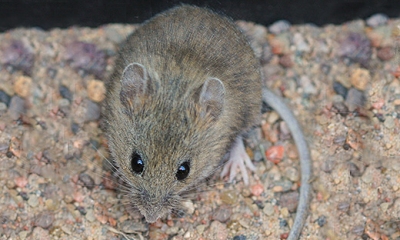
The Western harvest mouse is the smallest sigmodontine rodent in Oregon. It occurs east of the Cascade Range, except it is absent from the Blue and Wallowa mountains; it also occurs in the southern parts of Josephine and Jackson counties west of the Cascades.
The Western harvest mouse commonly uses runways. It is active nocturnally with its greatest activity between sunset and sunrise. They spend periods of inactivity in ball-shaped nests constructed on the surface of the ground; nests are sometimes placed beneath shrubs or debris.
Photo by J. N. Stuart, Flickr

The California vole is a medium-sized vole with a cinnamon-brown to tawny-olive dorsum overlain by dark brown or black hairs. The underparts are medium gray, sometimes washed with buff; the tail is bi-colored, black above and gray below. The feet are grayish.
It occurs from near Eugene south through the interior valleys of Oregon and most of California. It has been found in the drainages of the upper Willamette, Umpqua, and Rogue rivers in Lane, Douglas, Jackson, and Josephine counties.
This vole spend most of the time underground in its burrows or in those of other species; it makes only brief above ground excursions.
The canyon mouse is a moderate to small-sized mouse-like rodent with a long tail, nearly naked ears and a long, lax, and silky dusty gray pelage.
In Oregon, most locations where the canyon mouse has been found are in Harney and Malheur counties, but the distribution includes a group of localities in Crook, Jefferson, Wasco, and Wheeler counties and another group in Lake County. There are also records of the species in extreme southeastern Baker County. Rock, primarily rimrock and talus slopes, seems to be the key component of habitats occupied by the canyon mouse.
They are usually active nocturnally and are active throughout the year. Canyon mice are unusually agile. They carry their long tails arched over their backs, commonly squeeze into narrow crevices, and frequently make jumps as long as 20 cm.
The gray-tailed vole is a medium-sized vole with yellowish-brown or yellowish-gray dorsal pelage and a short tail, blackish or brownish above and light gray below.
It is endemic to the Willamette Valley and occurs from near Scapoose and Gresham south through the Willamette Valley to near Eugene. It is associated largely with agricultural lands, particularly small grains, grasses grown for seed, permanent pastures and hay fields, and waste places vegetated with grasses. These voles occasionally become so abundant that control measures are necessary.
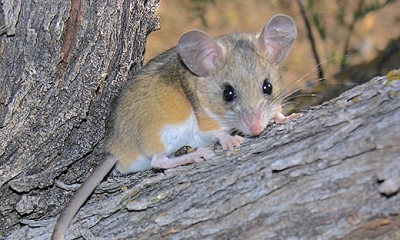
The deer mouse is a moderately small mouse-like rodent that exhibits considerable variation in color, tail length and markings. In general, the pelage of adult deer mice is buff to dark brown on the dorsum and white on the venter. The ears are moderately long, essentially naked and usually held erect and directed forward. The eyes are black and beady.
The deer mouse has the broadest distribution of any species within the genus and occurs throughout Oregon. Below the treeline, it occurs as part of essentially all communities.
It is active nocturnally, the time of onset of activity is cued by light and is remarkably precise, but does not seem to be influenced by clouds. It nests in trees, burrows in the ground, crevices in rocks, and a variety of other places. Communal nesting is observed frequently.
Photo by Gregory Smith, Flickr
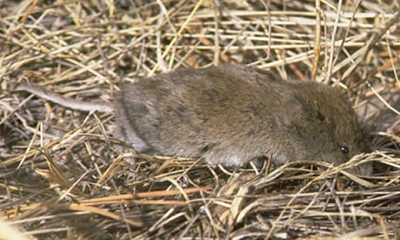
The long-tailed vole usually is considered to be a medium-sized vole, although the size of an exceptionally large male may rival that of the largest Townsend's vole. The color of the dorsal pelage ranges from dull grayish through brownish gray to dark sepia brow. Those west of the Cascade Range have the darkest and richest-colored pelages. The sides are lighter and more grayish and the venter is grayish white to dull buff. The eyes and ears are large.
In Oregon, the long-tailed vole occurs in 30 of the 36 counties. It is absent from the Willamette Valley and other interior valleys west of the Cascade Range. Within its rang,e it occupies a diversity of habitats: coniferous forest, thickets, forest-meadow ecotones, riparian zones, marshes, and grassy or sagebrush areas.
Ordinarily, the long-tailed vole does not construct runways similar to those made by many other species of voles; an exception is in grassy areas. In areas vegetated by sagebrush or chaparral, it leaves little or no evidence of its presence.
Photo from National Park Service
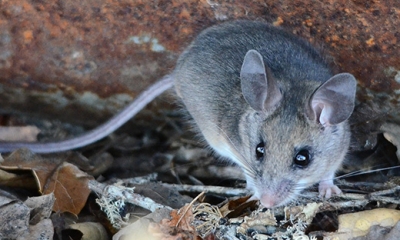
The piñon mouse is the largest member of the genus in Oregon. It is characterized by its enormous ears. Hair color varies geographically; overall, in central and eastern Oregon it is a pale-buff color with a wash of black on the dorsum, whereas mice from southwestern Oregon are bright ocherous on the shoulders and flanks and a dirty brown on the dorsum.
In Oregon, the piñon mouse has been found in Josephine, Jackson, Klamath, Lake, Deschutes, Jefferson, Grant, Crook, and Harney counties. East of the Cascade Range it is almost always associated with western juniper in rimrocks. In southwestern Oregon, it is associated with rocky outcrops vegetated by oaks.
Piñon mice are largely nocturnal.
Photo by Don Loarie, Flickr

The montane vole is a medium-sized vole. The pelage is ashy gray mixed with brown and black on the dorsum shading to light gray or whitish on the venter. The feet are lead colored and the tail is bi-colored black or dark gray above and light gray to whitish below. Splotches of different shades of yellow on the nose, venter, and dorsal surfaces of the feet and tail occur on some adult Montane voles.
This vole is distributed throughout most montane and intermontane areas of the west occurring throughout that portion of Oregon east of the crest of the Cascade Range, and at Diamond Lake and several localities in Jackson County west of the crest. It is essentially always associated with grassy areas, especially in mesic habitats along streams, in mountains, and in marshes. In grassy habitats, it constructs runways under the cover of the grasses.
Photo from USFWS

The Northern grasshopper mouse is a stockily built mouse with a thick tail. The dorsal pelage is dark sepia long the midline grading moderately sharply to a light tannish along the sides. The ventral pelage is white. A dark sepia line extends across the face between the eyes. The ears are thinly furred, sepia on the external surface and light grayish-tan on the internal surface. The feet and tip of the tail are white.
In Oregon, Northern grasshopper mice have been found in grassland and desert areas in Crook, Deschutes, Gilliam, Harney, Jefferson, Klamath, Lake , Malheur, Morrow, Sherman, Umatilla, and Wheeler counties.
These mice are strongly nocturnal, with peak activity at the new moon and minimum activity at the full moon. Light rain produces an increase in activity and heavy rain suppresses activity.
Photo by Gerson Herrera, Flickr
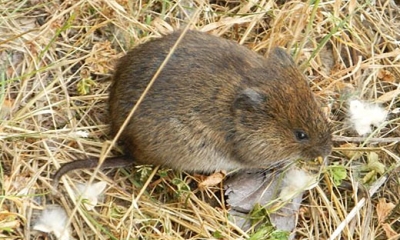
The creeping vole is the smallest vole in Oregon. It has an exceedingly short tail and tiny eyes. The short, dense fur on the dorsum ranges from sooty gray to dark brown or black, with scattered yellowish hairs. Hair on the venter is dusky washed with buff or white; the tail is blackish, slightly darker above that below; and the fur on the ears is black.
In Oregon, it ranges from Brooks Meadows and Crater Lake west to the Pacific Ocean. The species has been seen at some localities in the Willamette Valley. However, hiatuses in the distribution occur in the northern Coast Range and on the west slope of the Cascade Range in Clackamas, Marion and northern Linn counties and in southern Lane, Douglas, and northern Jackson counties.
Photo by Sarah Wilson, Flickr
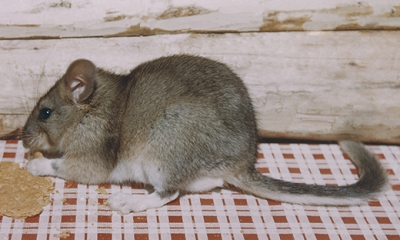
The bushy-tailed woodrat is a large rat-like mammal; its squirrel-like tail unique among members of the genus, is gray above and whitish below. The dorsum is buffy gray to dark brownish-black and the venter is white to buff depending on the geographic race.
It occurs, statewide in a wide variety of habitats. It is active nocturnally. Sometimes, upon leaving the protection of its den, the woodrat may lie motionless on a rock or limb, watching for a long period before moving forth.
Photo from ODFW

Other than the muskrat, the water vole is the largest arvicoline in Oregon. It occurs in the Cascade Range from Mt. Hoot to Mt. Mazama and in the Wallowa and Blue mountains east and north of a line connecting Langdon Lake, Umatilla County; the North Fork Malheur River, Grant County and Cornucopia, Baker County. It is considered an inhabitant of alpine and subalpine streamsides.
The water vole is active throughout the diel cycle; however, activity is least from dawn to midday, rises during the afternoon, and peaks at night, probably after midnight. It is a good swimmer and can swim against the current in small streams both on and below the surface.
Photo by Peter Trimming, Wikipedia

The dusky-footed woodrat is a medium-sized rat-like form with large, nearly naked ears, protruding eyes, and a long tail. The dorsal pelage consists of hairs with steel gray bases, a band of ocherous buff, and a tip of black. Hairs on the throat and belly are white. Although variably in extent, a dusky splotch occurs on the dorsal surface of the white feet.
In Oregon, this woodrat occurs from the California border northward along the coast to near Bandon, northward inland through the Willamette Valley and other interior valleys to near Mollala and Monmouth, and northward to Brownsboro, Jackson County, the Sprague River and Lake Albert south of the Cascade Range.
The dusky-footed woodrat constructs houses of sticks and other debris in trees or on the ground. Commonly, adjacent stick houses are connected by paths between ground level openings that lead to large central chambers through a maze of passageways. A central chamber is used for food storage; and some houses have a latrine. This woodrat is more active at night, but may be abroad during daylight hours.
Photo by Jacob Kirkland, Flickr
The Townsend's vole is a large vole with large ears that extend above the fur, a long brownish or blackish tail and brownish or blackish feet equipped with brown claws.
In Oregon, it has been found along the Pacific Coast south to southern Coos County, throughout the Willamette Valley with eastward extensions along the Columbia River to near Hood River; the McKenzie River to Douglas County; and the Rogue River to Prospect, Jackson County. With few exceptions, Townsend's vole is associated with moist habitats: meadows, lowland pastures, riparian zones, boggy lands, marshes, and irrigated fields densely vegetated with grasses and sedges.
It is active t throughout the year and thought the diel cycle. It readily enters the water and is a good swimmer and diver. These voles construct and use a complex system of runways. Nests of grasses are constructed above ground on hummocks in winter but below ground in summer.
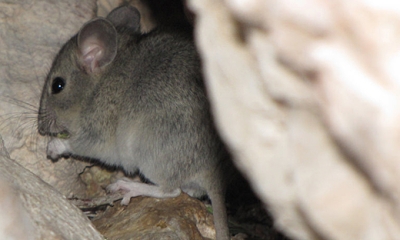
The desert woodrat is the smallest member of the genus that occurs in Oregon. The tail is round, short and bicolored and the ears are long and lightly furred. The pelage is long and soft, a mixture of buff and black dorsally and whitish or light buff ventrally; except for he chest, all body hairs have lead-colored bases. The feet and underside of the tail are white.
It occurs in Malheur, Harney, and southern Lake Counties. Throughout its range, it tends to be a habitat generalist, but in Oregon it usually occurs in sagebrush habitats, especially those associated with rimrocks or other rocky outcrops.
Desert woodrats are active nearly exclusively at night to avoid temperature extremes. They construct houses of sticks, dried cow dung, and a variety of miscellaneous items. Usually, houses serve to guard entrances to burrows appropriated from other small mammals or to fortify crevices in rocks.
Photo by Bryant Olsen, Flickr
The sagebrush vole is among the smaller voles in the state. The tail does not exceed the length of the hind feet. The long, soft, and dense dorsal pelage is grayish tan; the bases of the hairs are lead colored and the tips are black. The ventral pelage is pale buff, the feet light gray, and the tail slightly bicolored.
In Oregon, it occurs mostly east of a line connecting The Dalles, Bend, and Klamath Falls, except it is absent from the Columbia Basin and most of the Blue and Wallowa mountains.
Clustering of burrows tends to indicate that the sagebrush vole resides in colonies. Uncovered trails are formed between burrow systems, escape tunnels, feeding stations, and food sources.
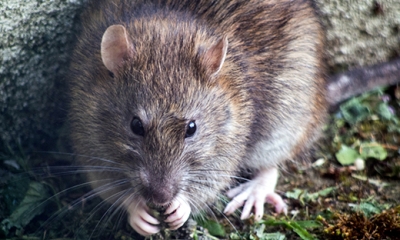
The Norway rat is the largest member of the subfamily in Oregon. This heavy-bodied rat has a scantily haired, scaly tail shorter than the length of the head and body. The ears are membranous and lightly furred. The pelage is course, a grizzled brownish or rusty gray dorsally and dirty white to yellowish gray ventrally. Albino, melanistic, and spotted specimens are known to occur in free-living populations.
This rat is distributed throughout the world in association with humans and in Oregon is found in most of the counties west of the Cascade Range and from some counties along the Columbia River east of the Cascade Range. It is a native of China and Siberia.
The Norway rat nearly always resides near human activity. In urban areas, rats occupy houses, warehouses, stores, sewers, garbage dumps, and any other place that provides adequate shelter and a nearby source of food. In rural areas, they reside in houses, barns, sheds, poultry coops, stables, granaries, silos, greenhouses, haystacks, woodpiles, refuse piles and almost any other type of structure in which livestock feed or foodstuffs for human consumption are stored or are available nearby.
Photo by Brett Jordan, Flickr

The common muskrat is the largest arvicoline rodent on Oregon. The body is heavy and rounded, and except for the tail and feet, heavily furred. The eyes are beady; the ears are rounded and almost covered with fur; the tail is flattened laterally, scaly, keeled, and naked except for a few hairs on the keel. The forefeet are relatively small, but the hind feet are large and partly webbed. The pelage consists of an exceedingly dense underfur usually overlain by glossy dark-brown guard hairs; the underfur is waterproof. Reddish, blackish, silvery, and white individuals have been recorded.
In Oregon, muskrats originally were distributed throughout the Willamette Valley and coastal regions as far as Coquille, Coos County, and east of the Cascade Range east of a line from The Dalles, Hood River County, to Shirk, Harney County. High mountain regions and the Klamath, Summer, Albert, and Warner valleys were unoccupied. However, introductions to unpopulated lakes and marshes in Lake, Klamath, and Curry counties have been chronicled.
Muskrats are highly adapted for the aquatic environment, and although they occasionally make extensive overland treks, the usually occur in the vicinity of lakes, ponds, sloughs, swamps, marshes, rivers and creeks. Muskrats are powerful swimmers and can stay submerged as long as 20 minutes.
Photo by Dave Budeau, ODFW

The black rat is slightly smaller than the Norway rat, but much larger than the house mouse, the only other members of the subfamily in Oregon. The black rat is similar to other members of the subfamily in that it possesses a scaly, scantily haired tail; membranous, nearly naked ears, and a soft pelage. It differs from the Norway rat in having a tail much longer than the length of its head and body and commonly having a darker-colored pelage. The pelage ranges from black to sandy brown dorsally and from lead colored to nearly white ventrally.
The black rat occurs nearly worldwide. It is a native of southeastern Asia. In Oregon, it has been found in Portland, Salem, and several smaller cities along the Coast. These rats are restricted largely to port cities and coastal regions in Oregon, where they are associated with human enterprises/ wharves; piers; dockside warehouses; piles of crates, nets, traps and debris; barns; houses; and waterfront stores. Feral populations of the species also inhabit wet coastal forests in some areas.
Black rats are agile climbers and accomplished wire-walkers. Individuals in feral populations build nests of twigs and leaves in a log stump, or in the crotch of a tree.
Photo from Wikipedia
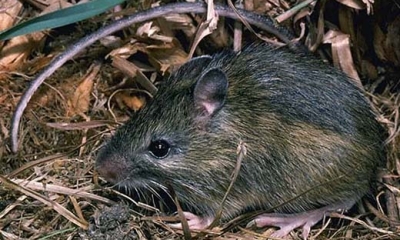
The Western jumping mouse is a long tailed, sleek-bodied mouse. The pelage is course. They yellowish-gray to ocherous sides are separated sharply from the pale-brown to grayish-brown dorsum; the venter is white, often washed with ochre. The tail is bicolored, but not markedly so.
In Oregon, the species occurs throughout most of the area east of the Cascade range except for the Columbia Basin-Deschutes Plateau region. It also occurs in southern Jackson County. Throughout its range, it is a denizen of mountain meadows, particularly those with small streams.
Without doubt, the most unique feature of the life cycle of the Western jumping mouse is its long period of hibernation - it is active for only two to two-and-a-half months.
Photo from Wikipedia
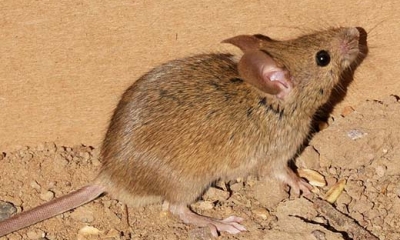
The house mouse is the smallest member of the subfamily in Oregon and smaller that most other members of the family. The ears are large and membranous; the tail is long, tapering, and scaly; and the soles of the feet are naked. The pelage is short, harsh, and usually grayish brown to nearly black dorsally, lighter brown or buffy ventrally. Albino, spotted, and other colormorphs are known to occur.
House mice occur throughout the world in association with humans. In Oregon, this mouse is found in 30 of the 36 counties. House mice are usually more active at night, but within barns, warehouses, and other buildings with subdued light, they may be active at any time. Even when active, these mice usually spend most of their time behind or beneath some object and dash between the items that provide cover.
Photo by J. N. Stuart, Flickr
The Pacific jumping mouse is a long tailed, sleek-bodied mouse. The pelage is course. The ocherous sides are separated sharply from the tawny dorsum; the venter is white, often washed with ochre. The tail is bicolored, but not markedly so.
In Oregon, the species occurs in the Cascade Range and westward to the Pacific Ocean except for southern Jackson County. These mice are largely marsh and meadow dwellers but are often found along creek banks or under ferns and weeds in the woods.
In September and October, these jumping mice become exceedingly fat; in captivity, they become progressively less active. In their hibernacula, they curl themselves into a tight ball, then wrap their long tails around their curled bodies.

